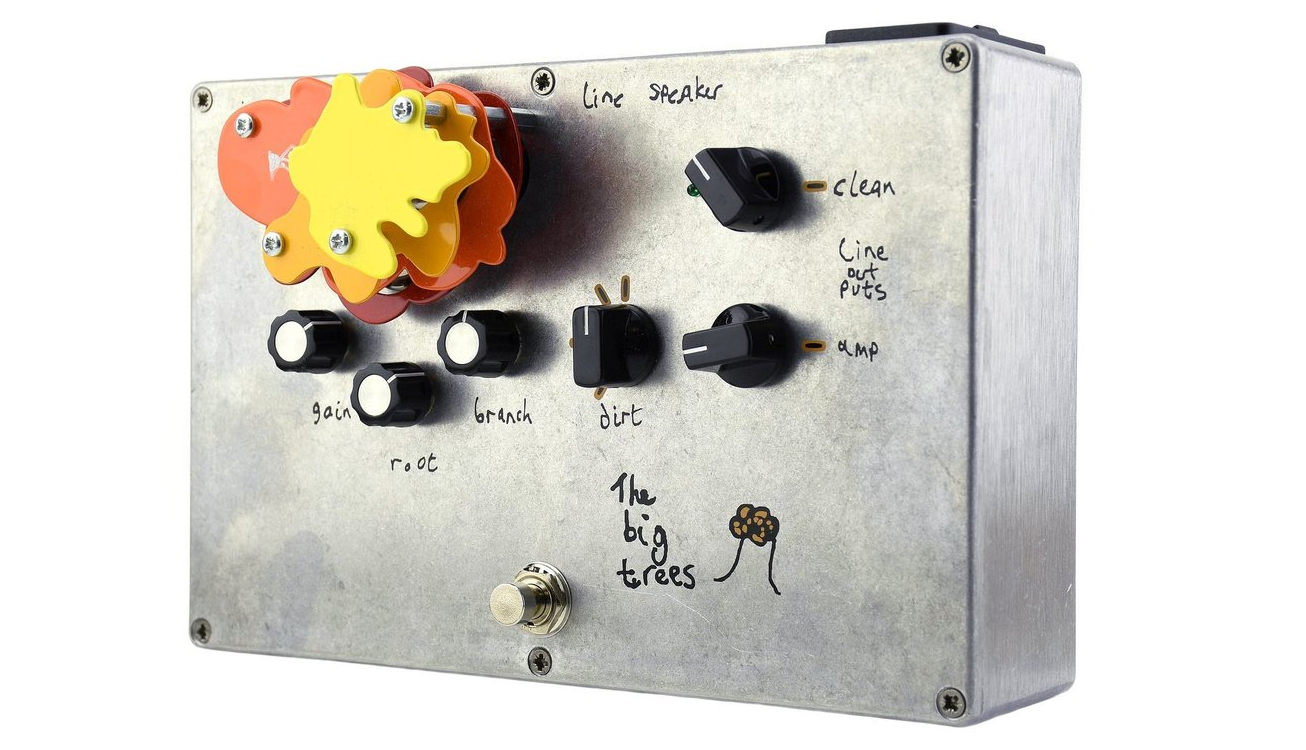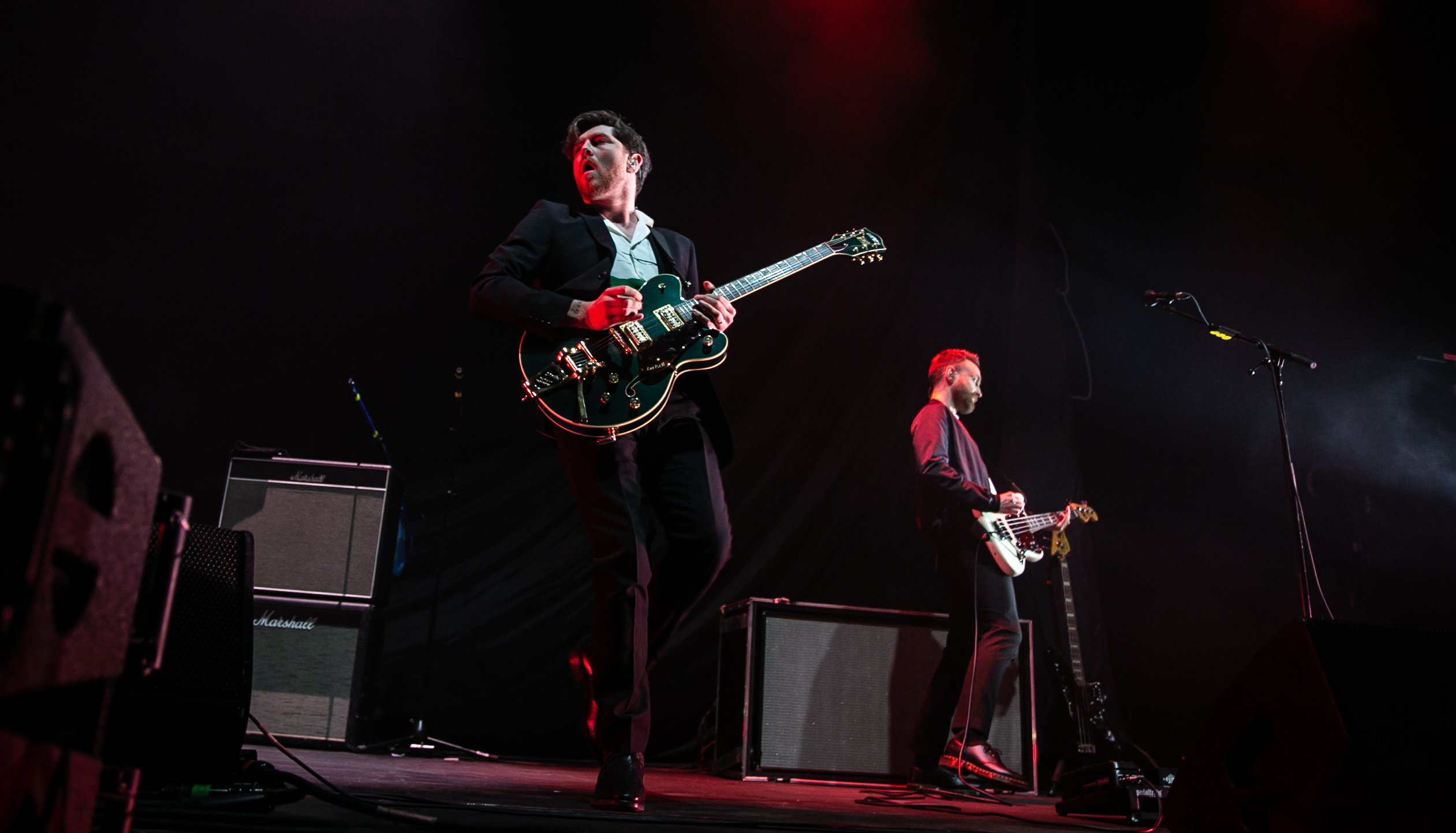Twin Atlantic's Sam McTrusty: my top 10 tips for guitarists
“A lot of the bands we took influence from were so into their gear – I feel like the tones were as important as the songs”

“A lot of the bands we took influence from were so into their gear – I feel like the tones were as important as the songs,” explains Twin Atlantic singer/guitarist Sam McTrusty, talking to MusicRadar not long before the release of the Scottish rock group’s fifth studio album, Power. It’s a notion that resonated with him from early on…
“If money was no object I’d have The Edge’s setup, with all those vintage Voxes and racks! Before I got a Kemper Profiler, I was running up to four different amps – some Marshalls and a Fender combo round the back with a rug over the top of it, which only kicked in on certain fuzz pedals. It was outrageous and expensive… the Kemper has been a life-saver purely because I can hand over two cables and stop other people fucking my sound up.”

The frontman has now switched to a hybrid set-up for live shows to get the best from both worlds, citing the Kemper Kone speakers made by Celestion – launched at Winter NAMM 19 – as the perfect middle-ground to breathe life into his favourite Fender, Vox and Marshall profiles, as explored on his 2017 Rig Tour. The new speakers will be put to test over the UK dates stretching across the first few months of the new year…
“Those new Celestions give a full frequency range, which is different to what you find in most cabs,” continues McTrusty. “They’re basically studio-quality speakers made specifically with the Kemper in mind. I’ve always found tones would sound amazing until you put the cab simulation on, which would then make everything sound too thin or muddy.
"I felt like I was starting to miss the air being pushed on stage, so will be using these speakers for touring. They take away that sterile digital squelch… but maybe I notice it more because I used to use different valve amps for each channel!”
Here the Twin Atlantic leader offers his 10 tips for guitarists…
1. Try using a semi-hollow

“If you take it right back to even just getting a semi-hollow out of the case, you pick it up and that thing resonates with a solid core unplugged. It just feels like a solidbody plus, if you know what I mean.
Want all the hottest music and gear news, reviews, deals, features and more, direct to your inbox? Sign up here.
As soon as I got that Gretsch, I was able to use gain and play without all the feedback you’d get with a fully hollow-body, with also a richness to the mids that a solidbody doesn’t seem to have
There are some which have been unsatisfying and total garbage, feeling too boxy when their so hollow. I’d never played one until I got a Gretsch Panther. I started using three different amps for my low, mid and high-end. They would all be EQ'd differently… I found that one amp and a single-coil solidbody would be just too mental. The clean was too pointed in tone and the low end felt kinda fizzy.
"As soon as I got that Gretsch, I was able to use gain and play without all the feedback you’d get with a fully hollow-body, with also a richness to the mids that a solidbody doesn’t seem to have. A lot of those sounds don’t quite ring out as well because they don’t exist on solidbody, it just doesn’t happen so you can’t amplify it.
"But you can simulate it by turning up the bottom end on your amp but you lose some of the openness to your tone. EQ can start sounding harsh. If your point of origin is resonating already, you will get a richer sound. I actually went back to touring just one amp after switching to semi-hollows.”
2. Learn how to control feedback

“We gain it up a lot more live… it does get a bit more Metal Zoney! Sometimes the way you are facing can make a huge difference. I’m lucky because I’m a singer, so I’m generally not pointing back to the amp.
"I always found a Noise Suppressor at the end of the chain was a big help when I was running just analogue and even now using my Kemper, I rely on the built-in gate which despite being a hard gate still manages to sound quite natural. Some gates can be way too harsh and abrupt.”
3. Cut your gain by a third

“I think a lot of players search for more and more gain when the listener might not want it. I guess it depends on the situation, but it’s an important thing to keep in mind.
I think a lot of players search for more and more gain when the listener might not want it
"The funny thing is when I’m playing, I like to keep turning everything up but when I’m recording other people, I’m always telling them to calm down on the distortion.
"I’d suggest putting up to the kind of gain you like and then turning it down by a third – you might be surprised by how much better it will sound.
"One of my favourite overdrives ever made is The Big Trees by Audio Kitchen, which we’ve used on pretty much every single guitar track we’ve ever recorded on a full-length album. I’m not lying, every single take has gone through that as either a gain-stage before or just blended in later.”
4. Make each and every part count
“The reason we made this Power record sound the way it does was because there’s currently an aversion to guitar. I find a lot of modern popular music seems to be turning it down – still having it there but keeping it at a really offensively polite volume. That’s just not the spirit of guitar.
If you think about the best solos, they can get a bigger reaction than the singer doing the chorus
"Just don’t have it if you’re going to fucking turn it down, that’s my take anyway. We’ve gone through a bit of a rollercoaster when it comes to record labels and conversations about guitar music not selling. Almost offensive experiences, if I’m honest! But we decided that guitars are the star of the show, more than a frontman.
Because if you think about the best solos, they can get a bigger reaction than the singer doing the chorus. It can be the biggest moment of the song... a complete arrival. That’s why guitar is the most complicated instrument of them all, it can be so influential with such little effort. I’ve made records where there have been over 100 tracks of guitar, I was probably trying to beat Smashing Pumpkins’ record and decided to keep going. We’ve gone full circle now.”
5. Think about the bigger picture
“I love how Depeche Mode made electronic rock with layers of dark, euphoric synths and yet one single guitar part could still be the star of the show. They don’t layer it up, they just have it almost three times louder than the synth parts.
"I’m not sure if Martin Gore been truly recognised in terms of how influential and important he is as a British songwriter. He uses the guitar for sounds rather than the conventional way. Listen to the riff in Personal Jesus… it’s frustratingly simple, but you’ll never write a riff as good as that! Just a handful of notes.
"Only one person could have written that riff ever and it was him. I often find him overlooked in these kinds of discussions, plus he’s a fellow Gretsch player ha ha!
"Rock music right now is considered uncool, antiquated and stuck in its ways… and it is! So when reinventing ourselves with synthetic sounds to get that low end and clear high end, at least in the studio, we thought we wouldn’t layer up the guitars. Instead, we matched the ego of rock… we stuck to one or two guitar parts at double the volume of everything else! That came out of our love for Nine Inch Nails and Depeche Mode.”
6. Pay strict attention to the lower frequencies
“One thing I’ve learned to always keep an eye on the low-end. If you have too much or not enough, it can really affect people’s perception of the quality. High end is quite easy to record, you can recording things on your phone and it will sound close to real life.
It’s much harder to recreate and convey lower frequencies down smaller speakers playing radio or iPhones
"It’s much harder to recreate and convey lower frequencies down smaller speakers playing radio or iPhones. That’s another reason why semi-hollows work for me.”
7. Experiment with ribbon mics

“I’ve gotten more and more geeky about mic placements and pre-amp choices over the years. I found ribbon mics are an absolute must. People usually use a large diaphragm condenser mic, normally used for vocals or drum overheads, because it captures a lot of detail along with an SM57-style dynamic mic to capture the transience and punch of the strings. But that’s not really the body of noise or the push of the air from the speaker you hear in the room.
I find ribbon mics capture much darker sounds and more of the room
"It’s an unrealistic capture… when do you ever put your ear that close to the cone? I find ribbon mics capture much darker sounds and more of the room. When you blend it in, your guitar sound can go from good to HD quality. It doesn’t need to sound great alone, it can even sound muffled when you solo it, but the idea is to blend in the lows and low-mids.
"A really good affordable one that we used on the album was the t.bone, which are only around £80 on Thomann. On the higher end, you could get a Royer ribbon which go for a grand or so, that isn’t much to pay if it matters to you...”
8. Get some candy from your pedalboard

“There’s a great tip we learned when we worked with a producer called Jacknife Lee, who has recorded Weezer, U2, Snow Patrol, Two Door Cinema Club – which is a broad spectrum of tones. He uses a pedal made by ToneCandy, it’s a spring reverb pedal, but if you turn the mix completely off it acts basically like a preamp.
"It makes guitars sound so much more present, but without overdoing the treble. Whenever we’ve recorded since, we’ve put it in the chain first and had it turned off. It’s only £120 or so and you can really hear the difference. It makes your guitars more vivid and lifelike, without distorting or adding any crunch.”
9. Go back to basics when facing creative blocks
“I always try to think about what a riff makes me feel. I go back to that basic childlike intuition that you don’t really get taught – does it scare you, make you happy or sad or both? Does it sound like a movie or a poem? What does it spark in your imagination? You need to have that frank internal conversation with yourself.
Being honest about what the music makes you feel really clears up all the bullshit
"It doesn’t have to be crying because you’re heartbroken or whatever, people often think that’s what an emotional song is about. It really doesn’t. I can feel nostalgic about the pattern on the carpet of my aunt’s house when I was growing up – there might be a riff out there that, for some reason, makes me go back.
"You can feel nervous and scared, yet hopeful at the same time. I find registering that feeling helps me understand what to do next… it doesn’t make sense to go from extreme to extreme. That’s what a bridge is for, an emotional conduit to help get you to that next emotion.
"We all know what sad chords sound like. We all know how solid a G chord can sound. Being honest about what the music makes you feel really clears up all the bullshit. The path starts to appear in front of you. Thinking too much about theory or technique or other guitar players will send you round in circles. You have to think about your own story.”
10. Save open chords for the moments that really matter

“Open chords will always sound bigger, but not necessarily better. Think about the open E power chord on the thickest strings compared to it an octave up on the seventh fret of the A string. Each has its different mood, one sounds huge and the other sounds tight, controlled and tense.
The most sustain you can get out of a guitar is on an open note, so use them in the right moments even if it means you have to rearrange the song and build drops rather than lifts
"Over the years I’ve learned to save those open strings for the moments that are important, where you want to sound open, wider and deeper. The most sustain you can get out of a guitar is on an open note, so use them in the right moments even if it means you have to rearrange the song and build drops rather than lifts.
"I might even change the tuning to allow the song to switch in direction. I think rock music suffers at times because it just builds up and up and up. It starts becoming a bit pantomime.
"I started to do that and realised it was like throwing sugar all over a cake, making it way too sickly. Sometimes you need to think about why certain parts should be open… unless you’re in Tool and open always sounds amazing because you can handle it!”
Power is released on 24 January via Virgin EMI. They tour the UK in January and March - see twinatlantic.com for dates.
Amit has been writing for titles like Total Guitar, MusicRadar and Guitar World for over a decade and counts Richie Kotzen, Guthrie Govan and Jeff Beck among his primary influences. He's interviewed everyone from Ozzy Osbourne and Lemmy to Slash and Jimmy Page, and once even traded solos with a member of Slayer on a track released internationally. As a session guitarist, he's played alongside members of Judas Priest and Uriah Heep in London ensemble Metalworks, as well as handling lead guitars for legends like Glen Matlock (Sex Pistols, The Faces) and Stu Hamm (Steve Vai, Joe Satriani, G3).
